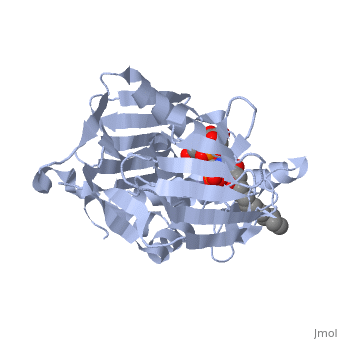UDP-3-O-acyl-N-acetylglucosamine deacetylase
FunctionUDP-3-O-acyl-N-acetylglucosamine deacetylase (LpxC) is a Zn-dependent protein which participates in the biosynthesis of lipid A. Lipid A anchors lipopolysaccharides into the membrane of Gram negative bacteria. LpxC catalyzes the conversion of UDP-3-O-[(3R)-3-hydroxymyristoyl]-N-acetylglucosamine to UDP-3-O-[(3R)-3-hydroxymyristoyl]-N-glucosamine[1]. (PDB code 4mdt).
Para-(benzoyl)-phenylalanine as a potential inhibitor against LpxC of Leptospira spp.: Homology modeling, docking and molecular dynamics study [2]Leptospira interrogans, a Gram-negative bacterial pathogen is the main cause of human leptospirosis. Lipid A is a highly immunoreactive endotoxic center of lipopolysaccharide (LPS) that anchors LPS into the outer membrane of Leptospira. Discovery of compounds inhibiting lipid-A biosynthetic pathway would be promising for dissolving the structural integrity of membrane leading to cell lysis and death of Leptospira. , a unique enzyme of lipid-A biosynthetic pathway was identified as common drug target of Leptospira. Herein, homology modeling, docking, and molecular dynamics (MD) simulations were employed to discover potential inhibitors of LpxC. A was constructed in Modeller 9v8. between active site of target and template (LpxC from Pseudomonas aeruginosa, PDB entry 2ves) in the presence of BB-78485. The color code representations as deep pink: target; green: template; cyan: BB-78485 in complex with target; and darkmagenta: BB-78485 in complex with template. Zn ion represented as sphere. A data-set of BB-78485 structural analogs were docked with LpxC in Maestro v9.2 virtual screening workflow, which implements three stage Glide docking protocol. Twelve lead molecules with better XP Gscore compared to BB-78485 were proposed as potential inhibitors of LpxC. Para-(benzoyl)-phenylalanine – that showed lowest XP Gscore (−10.35 kcal/mol) – was predicted to have best binding affinity towards LpxC. MD simulations were performed for LpxC and para-(benzoyl)-phenylalanine docking complex in Desmond v3.0. Trajectory analysis showed the docking complex and inter-molecular interactions was stable throughout the entire production part of MD simulations. The results indicate para-(benzoyl)-phenylalanine as a potent drug molecule against leptospirosis. 3D Structures of UDP-3-O-acyl-N-acetylglucosamine deacetylaseUDP-3-O-acyl-N-acetylglucosamine deacetylase 3D structures Updated on 04-May-2025 {{#tree:id=OrganizedByTopic|openlevels=0|
}} References
|
| ||||||||||
